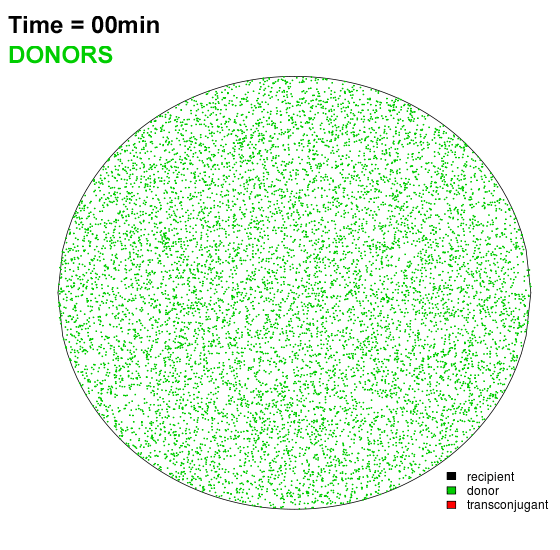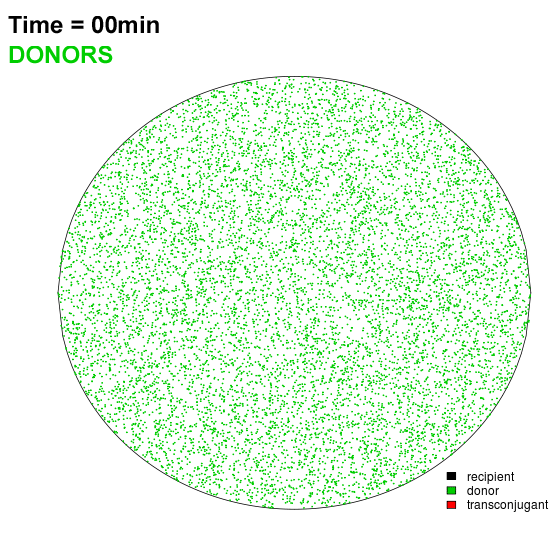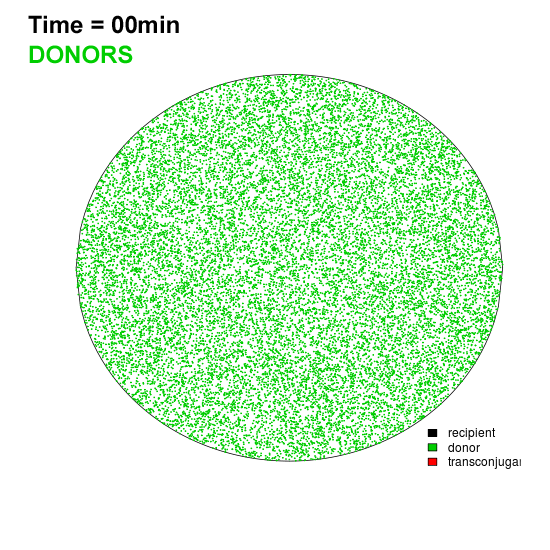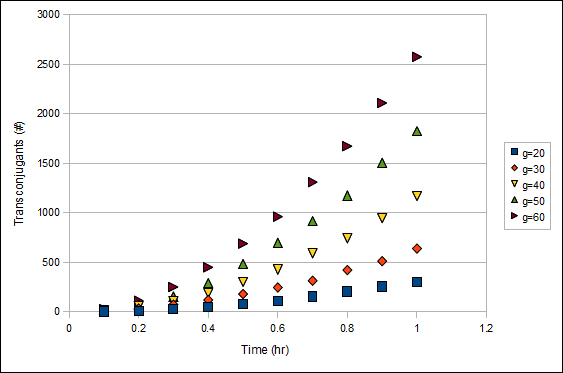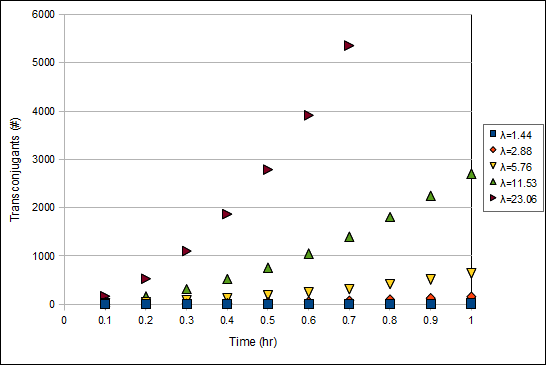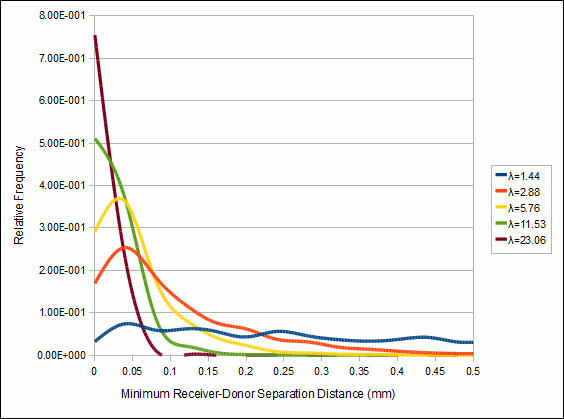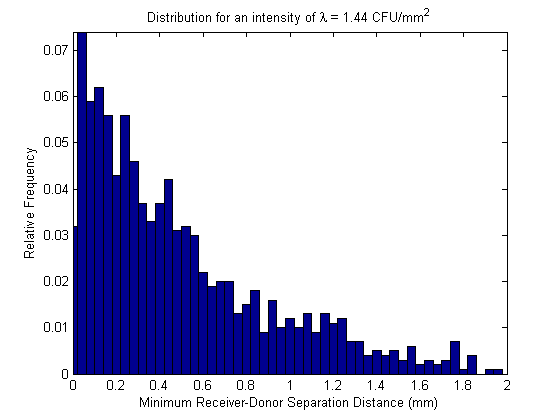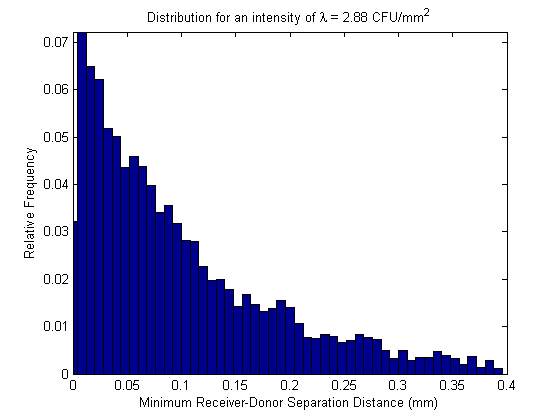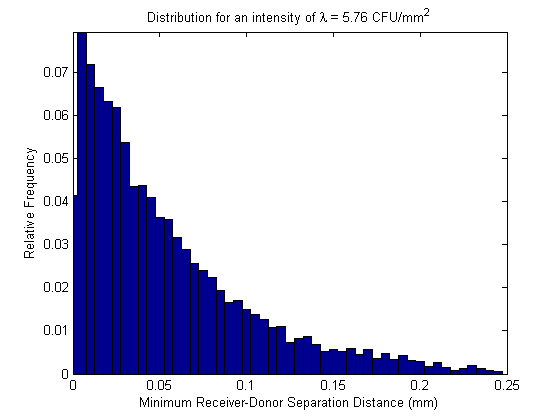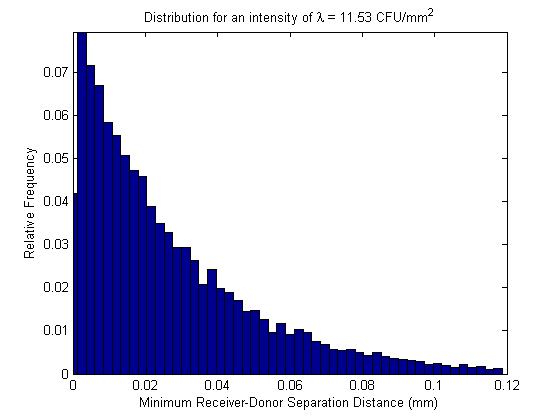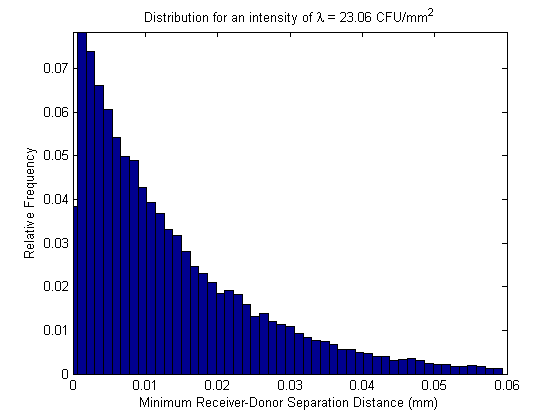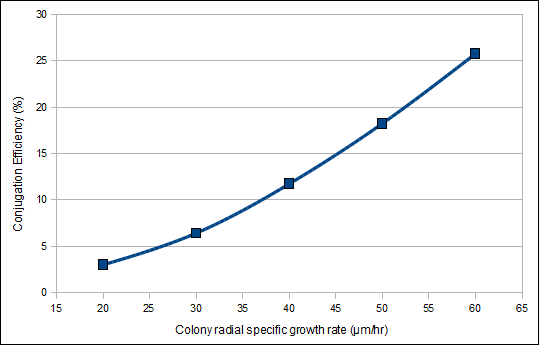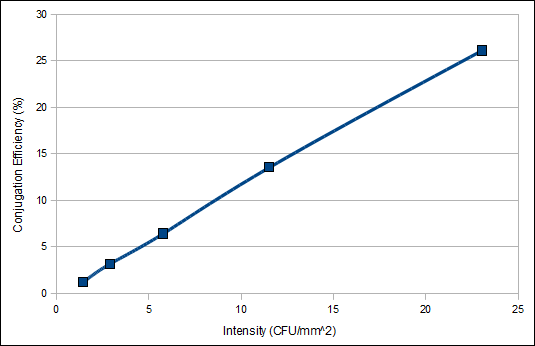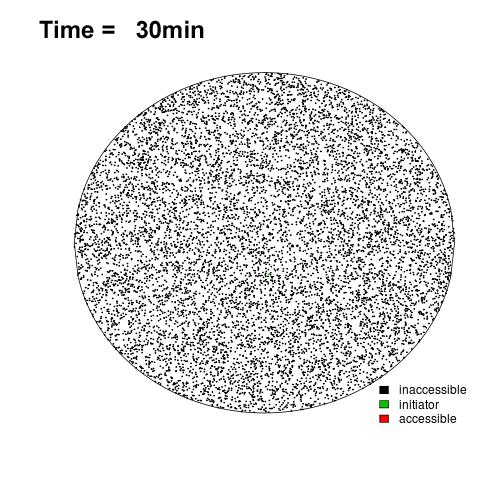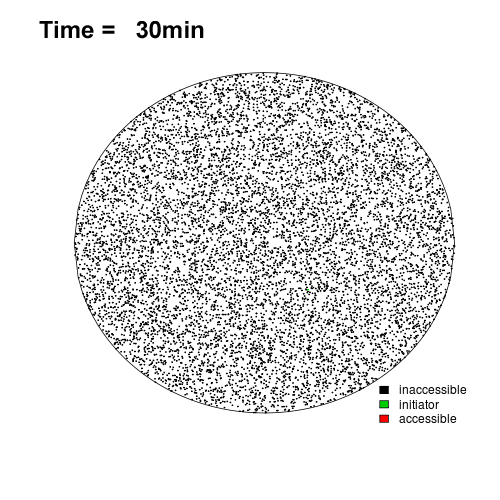Team:TUDelft/Modeling Conjugation
From 2009.igem.org
(→Conjugation Efficiecy) |
(→Distribution of Separation Distances) |
||
| (One intermediate revision not shown) | |||
| Line 70: | Line 70: | ||
We can see the Poisson distribution of separation values for various intensities in the graph below. | We can see the Poisson distribution of separation values for various intensities in the graph below. | ||
| - | [[Image: | + | [[Image:TUDdist-ci.gif|frame|center|Normalized distribution of separation distances between donors and recipients.]] |
{|border = "0" | {|border = "0" | ||
| Line 124: | Line 124: | ||
The animations below look at the effect of spatial restrictions on the propagation of the signal. Here a single initiator cell is plated along with 10,000 receiver CFU. Note that this is not the propagation of the signal itself, but merely the growth in the channel available for the signal to propagate through. The model will be able to show signal propagation once the delay time mentioned in Assumption #5 is implemented. | The animations below look at the effect of spatial restrictions on the propagation of the signal. Here a single initiator cell is plated along with 10,000 receiver CFU. Note that this is not the propagation of the signal itself, but merely the growth in the channel available for the signal to propagate through. The model will be able to show signal propagation once the delay time mentioned in Assumption #5 is implemented. | ||
| - | [[Image:1donor_gr30_ng099_set2.gif|frame|The growth in the 'channel' available for a signal to propagate through (Simulation 1).]] | + | [[Image:1donor_gr30_ng099_set2.gif|frame|center|The growth in the 'channel' available for a signal to propagate through (Simulation 1).]] |
| - | [[Image:1donor_gr30_ng099_set3.gif|frame|The growth in the 'channel' available for a signal to propagate through (Simulation 2).]] | + | [[Image:1donor_gr30_ng099_set3.gif|frame|center|The growth in the 'channel' available for a signal to propagate through (Simulation 2).]] |
| + | |||
| + | <br> | ||
| + | All of the source code used can be found on the [[Team:TUDelft/Downloads | downloads]] page. | ||
{{Template:TUDelftiGEM2009_end}} | {{Template:TUDelftiGEM2009_end}} | ||
Latest revision as of 17:31, 20 October 2009
Conjugation Modeling
Our conjugation modeling work is based on the paper [http://www3.interscience.wiley.com/journal/118837812/abstract?CRETRY=1&SRETRY=0 A model for bacterial conjugal gene transfer on solid surfaces] [10]. Using a slightly modified model we simulated our conjugation protocol for R751 cells conjugating on a 0.2 μm filter placed on agar for a period of one hour.
Assumptions
- The cells are distributed randomly on the filter at the start.
- The conjugation times used in our simulations are less than the time required to exhaust the nutrients in the medium.
- All cells form a colony (are CFU).
- All cell types (donors, recipients and transconjugants) have identical colony radial growth rates and specific growth rates.
- Conjugation occurs instantly when a donor colony touches a recipient colony. Future versions of the model will integrate a conjugation delay time once two colonies meet.
- Plasmid loss is not taken into account.
- Cells can not move over the surface except through expansion of the colony.
Parameters
The parameters needed for this model are:
- Surface area of media (A)
- Initial colony radius (r0)
- Specific growth rate (gn)
- Colony radial growth rate (gr)
- Maximum numbers of cells sustained by system (Nmax)
- Initial number of donors (Nd) and recipients (Nr)
Default values for these parameters can be found on the parameters page.
Spatial distribution of bacteria
The bacteria are initially distributed at random on the medium, so a distribution function to find the closest cell r would be:
![]()
where λ is the intensity (cells per unit area).
Growth of colonies
While the original model presented in the paper used an exponentially increasing rate for the colony radius, this was changed to a linear rate of expansion for our model. The radius at a point in time is given by:
![]()
Contact between colonies
Two colonies with radius r touch if their centers are less then 2r apart. The model checks this through an iterative process were it examines the separation distance between recipients and donors/transconjugants. Once this distance is less than 2r the receiver colony is turned into a transconjugant.
Conjugation modeling
A large number of simulations were done for various parameter values. The animations below show the creation of transconjugants at low and high values of gr and λ. Higher values of λ lead to more transconjugants since the colonies are closer together and higher values of gr lead to more transconjugants since the colonies come into contact sooner. Due to the assumption of instantaneous conjugation this model will tend to overestimate conjugation events. The magnitude of this overestimation is lower for smaller intensities (λ).
Plots from some of the other simulations can be found on the Conjugation Modeling Plots page. The influence of both gr and λ on the growth in the number of transconjugants can be seen in the graphs below.
Distribution of Separation Distances
We can see the Poisson distribution of separation values for various intensities in the graph below.
|
|
Conjugation Efficiecy
The end result of a conjugation test is a value for the conjugation efficiency. The data from the simulations performed was used to examine how the conjugation efficiency is affected by gr and λ. This calculation assumes that all colonies will create an equal number of CFU when the conjugation filter is resuspended and plated.
These plots show that care must be taken when comparing conjugation efficiencies from different tests. Attempts should be made to minimize the differences in conjugation efficiency to to differences in testing parameters. This dependence of the conjugation efficiency on the intensity was noticed during conjugation testing.
Signal Propagation
The animation below shows a simplistic view of a signal plasmid propagating outwards in a lawn of cells. The conjugation timing values are based on values given in [11, 12]
This estimate ignores the effect of cell division on the propagation speed. The predicted speed (8 to 20 μm/hr) is less than the speed of radial expansion of a colony (20 to 60 μm/hr). This implies that the signal propagation will have two modes:
- When a colony of cells containing the signal plasmid is growing. The signal plasmid will be directly transmitted to the daughter cells when the cell divides. In this mode the signal will propagate at the speed of the radial expansion of the colony (gr).
- When the edge of a donor/transcojugant colony meets the edge of a receiver colony the signal will slow down to the rates given in the animation above. The primary means of propagation in this mode is conjugation not cell expansion.
The animations below look at the effect of spatial restrictions on the propagation of the signal. Here a single initiator cell is plated along with 10,000 receiver CFU. Note that this is not the propagation of the signal itself, but merely the growth in the channel available for the signal to propagate through. The model will be able to show signal propagation once the delay time mentioned in Assumption #5 is implemented.
All of the source code used can be found on the downloads page.
 "
"
